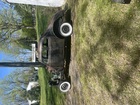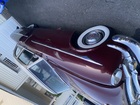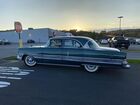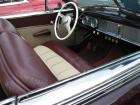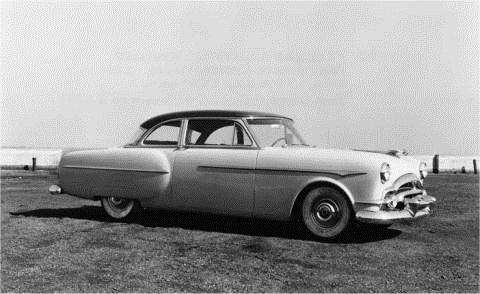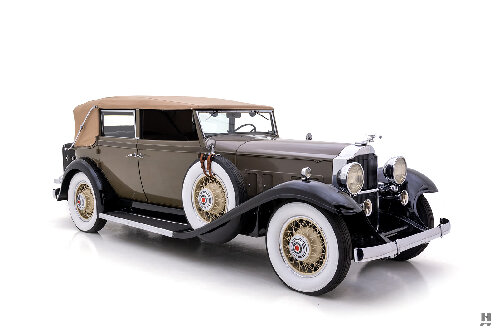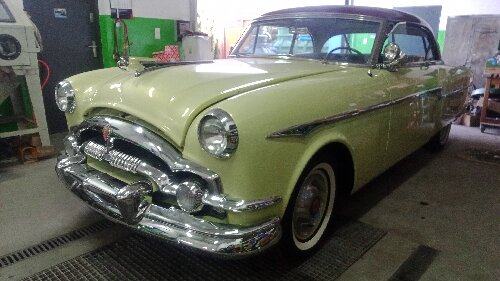|
Balancing 356 fan and water pump pulley
|
||||
|---|---|---|---|---|
|
Home away from home
|
I'm changing the water pump pulley on my '47 Super's 356 merely as the existing one has a small, thumbnail-sized chip on the rear outer flange. It doesn't harm the belt, but since i've a virgin spare, i'll use that strictly for the cosmetics, not that anyone else'll notice.
My existing pulley has the usual pair of balance holes drilled in the same area as the four bolt holes. My unchipped spare has no balance holes, and a friend who's been involved with these cars since the '50s can't recall ever seeing a 356 pulley without balance holes. Perhaps this one made it through inspection without requiring further attention? Just to play safe, since these 356 water pump pulleys are cast iron, heavy, i'm going to have a machine shop doublecheck it for balance. Since the fan's off, thought i'd have him check that, too, even tho' the fan looks fine, seemed to spin smoothly. Anyone ever have a 356 fan balanced? Did the shop balance it with the pulley, or separately?
Posted on: 2012/8/13 18:19
|
|||
|
||||
|
lightweight fan for 356
|
||||
|---|---|---|---|---|
|
Home away from home
|
Is there a lightweight/aluminum fan for the 356?
Posted on: 2012/8/8 14:35
|
|||
|
||||
|
Home away from home
|
Cousin Zougeride-- De nada. We like what we like. Decades ago, i briefly pondered a leather interior in a closed Packard. Believe me, i understand what you're doing and am no stranger to tasteful upgrades. Tho' usually inclined to shrug off what others will do, the suggestion of one poster, seemingly sincere, to use elephant hides,
ay yi yi. Here we are, preserving fine old automobiles, only to upholster them with the skin of remarkably intelligent, highly social, and endangered fellow creatures? I like to think Packard folk are a cut above that. Leave that to the Kadillackers. I urge any and all to Google or YouTube "elephants painting." That, and given that 1948-50 Packards were often called "pregnant elephants" in the day and since, well, that's just six ways to Sunday tasteless. A friend has the optional leather interior in his '36 Cord 810 Westchester (sedan). Whenever we take that barouche out for a spin ---usually because we're tinkering with it but that's a Cord for you-- it really doesn't feel luxe as you might imagine. And it smells like a giant version of the Al Kaline first baseman's glove i had as a lad. A mite overpowering. There are many quietly elegant, uber tasteful alternatives to the get-them-out-the-door mouse fur and other fabrics Packards and other high end automobiles used. One of the most elegant old road cars i ever saw was a silver gray '36 Lincoln K Willoughby sport sedan. The entire interior, including headliner, door panels, seat back, everything, upholstered in ultra thick English broadcloth. A symphony in gray. In 1941, Buick and Cadillac offered whipcord that wore like iron in their open models for those who didn't want leather. A friend with a beautifully done black '41 Cad convertible coupe had the interior redone back in 1971 with an ultra thick, heavy, burgundy hide of the nauga. He says it's no longer available today. But i find that hard to believe, and who knows what's available south of the border. I wouldn't give a dime for any Cadillac, but his looks magnificent, identical to leather, though without the stench, which gets real old after awhile. Saw a '35 or '36 Duesenberg SJ roadster delivered new to an Indian rajah with hide of the nauga. Similarly a Lagonda V-12 Rapide. Other upscale English cars in the mid '30s and beyond had such and you'd never know it from animal skin. So look before you leap. 'Course, i'm 100% on the Dr. Joel Fuhrman/Bill Clinton vegan diet for a number of reasons; better health than i've ever had, impossible to pack on extra pounds, enjoying more relaxed energy than ever, requiring less sleep, and i'd like to be around a few more centuries to play with my car. There are Iron Men marathoners, NBA,NFL players on this diet. I read in The New Yorker several years ago that Ingrid Newkirk, president of PETA, is a bigtime Formula One fan. Visit YouTube to watch a pair of brief vids. In one, "Bill Clinton, Fan of Caldwell Esselstyn, Jr. MD," which runs three minutes, eight seconds, Clinton shares his experiences with fellow heart surgery survivor Dave Letterman. In another, "Bill Clinton became a vegan, lost 24 lbs...." which runs only 2:29, he shares insight with Wolf Blitzer. Trust my fellow Packardites will forgive this wee divergence. But we've lost too many old friends in this hobby who'd still be with us, had they heeded the above. Oh -- i also lost 24 -- actually 27 lbs--- in addition to the 100+ lbs. i jettisoned from my '47 Super Clipper. Weight is the enemy of any serious road car, regardless how luxurious. Take care.
Posted on: 2012/8/7 15:35
|
|||
|
||||
|
Re: '40 Ignition cables recommendation
|
||||
|---|---|---|---|---|
|
Home away from home
|
I'll leave to others as to who purveys the best cosmetics, but make sure you find ignition wires that are 100% copper.
My '47 Super has genuine, decent, black ignition wire from a then 60-year-old auto electric shop now long gone, installed back in the '80s. Out here in Kaleefornyuh, you could, as recently as the '80s, find in many auto parts emporiums, pure copper ignition wire sold "for off road use only." As i recall, it was safety cone orange, stamped Packard 440, ironically part of what's left of James Ward Packard's original company. None of this helps you, but i just want to urge you and others to accept nothing but pure copper ignition wire. None of that ubiquitous carbon suppresor junk. Anyone following Cardinal Santana's detailed saga knows he's among those wanting his car to run as well as it looks.
Posted on: 2012/8/1 2:53
|
|||
|
||||
|
Home away from home
|
While you're at it, make sure to mount a huge pair of steer horns in place of the hood ornament, and one of those hot rod skull gearshift knobs. You'll also want to lower the car, put on some chrome mag wheels, perhaps replace the Packard engine with a rare Chevy V-8. And make sure you get enough large metalflake in the paint. None of
that subtle luminescent jazz. Metalflake, perhaps lollipop red, tangerine, purple, lime green. Don't forget the flames, scallops, pinstriping! And get rid of that factory radio and install a boom box, the louder the better. Whoa, yeah.
Posted on: 2012/7/31 16:25
|
|||
|
||||
|
Re: Gen. MacArthur's 8-45 limousine
|
||||
|---|---|---|---|---|
|
Home away from home
|
Thanks. I'd heard the 1946 or '47 Super or Custom Super sedan Harry and Bess Truman used as their personal car in Washington was dark blue, but don't know whether Packard, Coral, Atlantic blue. The above sounds interesting, but it's hard to imagine a car used by the Trumans not having some surviving documentation, some scraps of paper, something.
If not for some family investments, Truman would've been in the poor house or old soldiers' home, his only income after leaving the White House his old Army pension of $112.56 a month. Truman was a class act, made some of the toughest decisions in Oval Office history, including the toughest single decision in human history. You'd think a grateful nation might've let him keep a used Packard.
Posted on: 2012/7/29 23:54
|
|||
|
||||
|
Re: Gen. MacArthur's 8-45 limousine
|
||||
|---|---|---|---|---|
|
Home away from home
|
Is there NO END to this General MacArthur
nonsense? Some of us recall the article about "General MacArthur's Packard Clipper" in Special Interest Autos back in the late '70s. SIA, to their credit, soon printed a retraction, apology for swallowing that malarkey. However, time passes, and we again have some avaricious Sun Belter, dressed in comic opera War II uniform, passing off a Packard Clipper painted olive drab, with a machine gun mount bolted to the dash, requisite sunglasses and corncob pipe resting on the back seat. Please. Here and now, might we have a moratorium on this hohum? No more General MacArthur, or celeb cars in general, without hard, vetted proof. And really, who cares even if it was MacArthur's? Harry Truman fired him. My pappy served in the infantry, island-hopping toward Japan, recalled MacArthur being carried on the shoulders of a pair of MPs into shallow water, where they gingerly put him down. MacArthur, like a Hollywood pro, cued the newsreel boys, who filmed him wading heroically the remaining few yards to the beach. "Old soldiers never die...they just fade away..." What a maudlin phony. Nixon must've taken lessons. On the Phillipines, MacArthur used a '42 Cadillac 75 limo owned by a sugar cane plantation owner. If you have to have a former general's car, find one owned or used by Omar Bradley or George Marshall. They were class acts, widely respected by combat troops. What would be nice is to see pictures of the 1946 or '47 Custom Clipper 2106 sedan Harry and Bess Truman used to go shopping in Washington. I've heard they were accompanied by only one unmarked car with a couple Secret Service agents, tho' perhaps a lone black and white city police car kept them in view. Those were the days. Heard as recently as the early '80s, Margaret Thatcher, hardly the most popular prime minister, often ate lunch in a public restuarant accompanied by only one unarmed bobby, but i'll leave the veracity of that to one of our Sceptered Isle Packardites. "There's a such and such on EBay. The seller says it was owned by so-and-so." C'mon.
Posted on: 2012/7/29 19:23
|
|||
|
||||
|
Re: 1941-47 senior tail lights according to Hoyle and Packard
|
||||
|---|---|---|---|---|
|
Home away from home
|
Thank you, gentlemen!
Posted on: 2012/7/29 15:07
|
|||
|
||||
|
1941-47 senior tail lights according to Hoyle and Packard
|
||||
|---|---|---|---|---|
|
Home away from home
|
Asking this of any longtime senior owners who really know what Packard, the industry, Zeus, Minerva, Mr. and Mrs. America and all the ships at sea preferred, assuming there was a "right" way.
On both old body style 1941-42 One-Sixty/One Eighty, and their 1942-47 Clipper counterparts, all these having two bulbs in each tail light housing, which went on top, the single element turn signal bulb, or the dual-filament tail and brake light bulb? Please, only respond if you know what Packard/the industry preferred, not however your bulbs happen to be plugged in. Sure now, 'tis a wee matter, in the scheme of things. But our fine cars are a collection of details. Thanks.
Posted on: 2012/7/28 21:19
|
|||
|
||||

